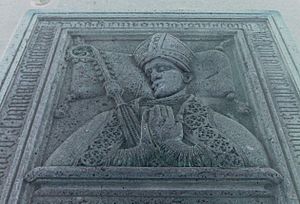Antipope Clement VIII facts for kids
- Antipope Clement VIII should not be confused with Pope Clement VIII.
Quick facts for kids Antipope, Bishop of Mallorca Clement VIII |
|
|---|---|

Tomb of Antipope Clement VIII in Palma Cathedral
|
|
| Papacy began | 10 June 1423 |
| Papacy ended | 26 July 1429 |
| Predecessor | Roman claimant: Martin V Antipapal (Avignonian) claimant: Benedict XIII |
| Successor | Roman claimant: Martin V Antipapal (Avignonian) claimant: Benedict XIV |
| Opposed to | Roman claimant: Pope Martin V Other claimant: Benedict XIV (Jean Carrier) |
| Other posts | Bishop of Mallorca |
| Personal details | |
| Birth name | Gil Sánchez Muñoz y Carbón |
| Born | 1369 Teruel, Crown of Aragon |
| Died | 28 December 1445 or 1446 |
| Buried | Palma, Kingdom of Majorca |
| Nationality | Spanish |
Clement VIII, whose real name was Gil Sánchez Muñoz y Carbón, was born around 1369 or 1370. He was known as an antipope during a time when there was more than one person claiming to be the true Pope. This period is called the Avignon Obedience. He served as an antipope from June 10, 1423, until July 26, 1429. When King Alfonso V of Aragon made a deal with the recognized Pope, Pope Martin V, Sánchez Muñoz stepped down. After giving up his claim, he was made the bishop of Mallorca.
Contents
Gil Sánchez Muñoz: His Life and Role
Gil Sánchez Muñoz was born in Teruel, a city in what is now Spain. This happened between 1369 and 1370. He became a close friend and advisor to Antipope Benedict XIII, who was another antipope from Avignon. Sánchez Muñoz was part of Benedict XIII's group of advisors.
How Clement VIII Became an Antipope
In 1396, he was sent to Valencia to get support for Benedict XIII in Spain. When Benedict XIII died, he had appointed four cardinals. On June 10, 1423, three of these cardinals chose Sánchez Muñoz to be the new Pope. He took the name Clement VIII.
However, the fourth cardinal, Jean Carrier, was not there. He said the election was not valid. Jean Carrier then chose his own antipope, who was called Antipope Benedict XIV. Because of this, Clement VIII officially removed Jean Carrier from the Church, a process called excommunication.
The King's Influence on Clement VIII
Clement VIII's position as an antipope was closely tied to the plans of Alfonso V of Aragon, a powerful king. King Alfonso wanted to make a deal about Naples, a kingdom in Italy. So, he supported Clement VIII. However, Alfonso's queen, Maria of Castile, and the bishops in Aragon supported the recognized Pope, Pope Martin V.
In the summer of 1423, King Alfonso convinced the Republic of Siena to accept Clement VIII. This meant that the Avignon line of popes was recognized in Pavia. Pavia was a city that was part of the Republic of Siena. This was important because the Roman Pope Martin V had called a major Church meeting there.
Clement VIII Steps Down
Later, a skilled diplomat named Cardinal Pierre de Foix helped King Alfonso and Pope Martin V reach an agreement. In 1428, King Alfonso sent a group of people, led by Alfonso de Borgia (who later became Callixtus III), to convince Clement VIII to recognize Martin V as the true Pope.
Clement VIII agreed to step down on July 26, 1429. To make sure there were no doubts about who the next Pope should be, he had his cardinals formally elect Oddone Colonna (Pope Martin V) as his successor. His decision to step down was confirmed in mid-August. Clement VIII had to formally apologize to Martin V. After he did this, Martin V made Sánchez Muñoz the Bishop of Mallorca. Sánchez Muñoz died on December 28, 1445, or 1446.
See also
 In Spanish: Clemente VIII (antipapa) para niños
In Spanish: Clemente VIII (antipapa) para niños

